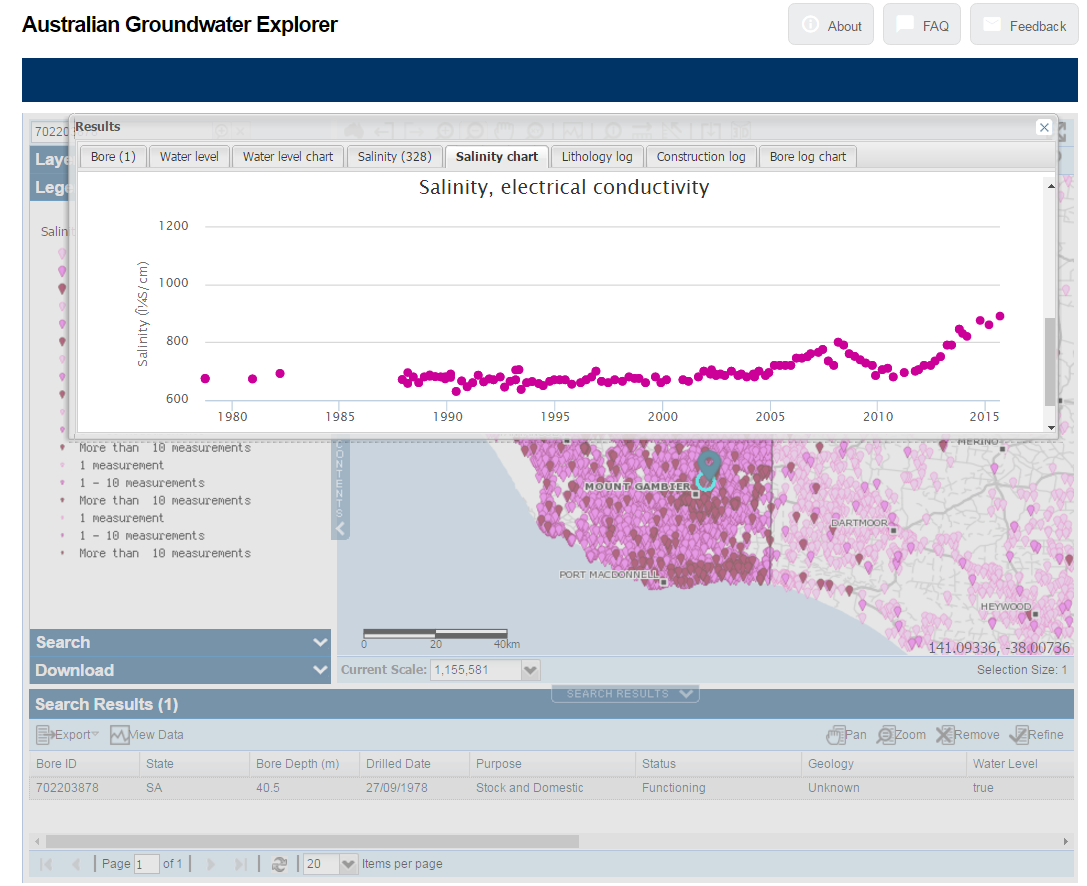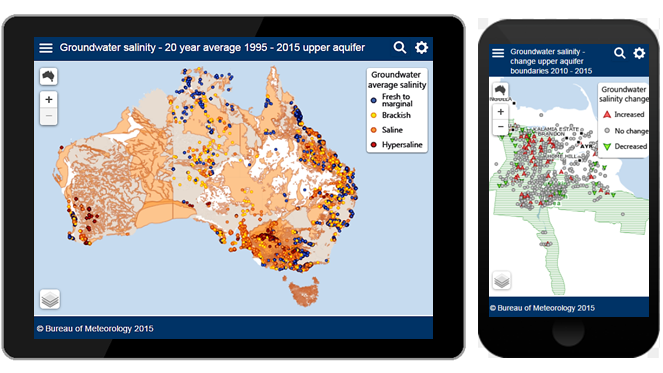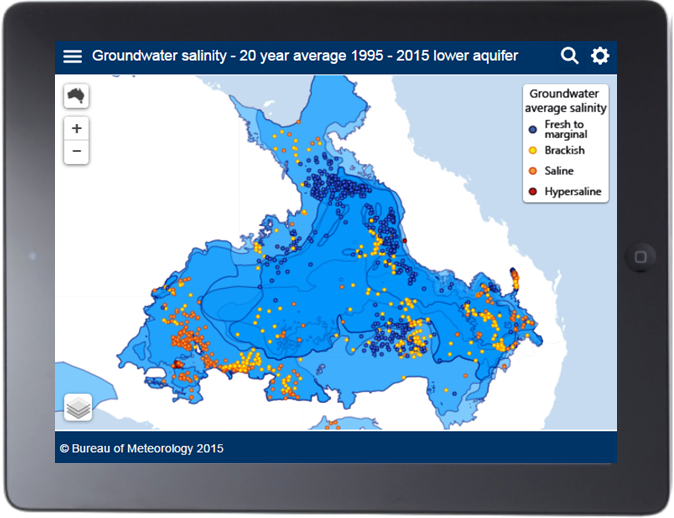Groundwater: is too much salt a bad thing?
30 August 2016
All natural water contains some level of salt, and in groundwater the concentration can naturally vary from fresh to saltier-than-seawater. While small amounts of salt are vital for life, high levels can limit groundwater use and affect ecosystems that depend on groundwater.
The Bureau has now added salinity information to its Australian Groundwater Insight portal, showing 20-year average groundwater salinity for over 16,500 bores across Australia. So what causes groundwater salinity and can salty water still be used?
What causes groundwater salinity?
Small quantities of salt are deposited onto the landscape every time it rains. Evaporation and plant transpiration remove water from the landscape but leave the salt behind. This concentrates salt over time. Evaporation can also directly increase groundwater salinity in areas where groundwater is close to the surface. Old groundwater can also become saltier as it passes through aquifers and picks up salts from dissolved minerals.
Although the presence of salt in the Australian landscape is natural, the salinity in groundwater and movement of salt into groundwater-dependent ecosystems can be increased by human activities. Increases in groundwater salinity can be caused by:
- increased groundwater recharge because of irrigation, which mobilises salts naturally accumulated in the soil (irrigation salinity);
- increased groundwater recharge because of land clearing, bringing groundwater in close proximity to the land surface, causing evaporation from soil surface and salt accumulation (dryland salinity);
- leaking pipes, over-watering of gardens and runoff from compacted surfaces can raise groundwater levels and concentrate salts in urban areas, which can lead to salt damage on buildings and roads (urban salinity);
- over-pumping near the coast, which can cause sea-water to seep in to replenish water levels.
Groundwater salinity can be also reduced at times, such as when rapid recharge from flooding flushes out or dilutes salty groundwater. Broadscale changes in groundwater salinity occur very slowly, over decades or longer. Therefore, groundwater salinity is usually monitored infrequently except where human impacts are of concern.
What are the impacts of salinity?
High levels of salinity can have detrimental effects on agriculture, infrastructure, and the environment.
Irrigation and dryland salinity can reduce the productivity of agricultural land and degrade the natural environment, leading to changed land use and other environmental and social impacts. The salts and waterlogging associated with urban salinity may damage infrastructure, reduce surface water quality when salts wash into waterways, and increase the cost of urban construction and maintenance.
However, despite the negative impacts of salinity, some aquatic environments have adapted to a range of salt concentrations.
Recently, improved salinity management practices have mitigated some of the effects of increasing groundwater salinity. The Report of the Independent Audit Group for Salinity 2013–14 states that the salinity target at Morgan on the River Murray was met for the fifth year in a row with the help of salt interception schemes, improved land and water management actions, and additional dilution flows (Jane Doolan et al. 2015). Contrary to common understanding, below-average groundwater levels during the Millennium Drought (1996 to 2010) also helped reduce the volume of salty groundwater discharged to surface water.
Insight into groundwater salinity
The term ‘salinity’ is used to refer to the concentration levels of salts. Groundwater salinity is extremely variable in Australia, naturally varying from fresh to highly saline. In fact, less than 30 per cent of Australia’s groundwater is of fresh to brackish quality (Herczeg 2011). The distribution of saline groundwater across Australia has a huge impact on the useability of groundwater resources.
Fresh groundwater is suitable for all uses including human consumption. Saltier water may be useful for irrigation or stock watering depending on the crops and animals. Very salty water may also have uses in some industrial or construction industries, but needs to be treated before it can be used. This generally only happens where no other water sources are available. Groundwater desalination plants operate in 35 locations across Australia, with a combined capacity of 76.9 GL per year (see our Climate Resilient Water Sources web pages for more information).
Bore by bore groundwater salinity values are available to view and download from the Bureau’s Groundwater Explorer (see figure below). Additional groundwater salinity information has also been recently added to the Australian Groundwater Insight.

Image: Graph showing time series of groundwater salinity for a selected bore (702203878 SA) available from the Bureau’s Groundwater Explorer portal.
Groundwater Insight shows two types of salinity maps: the 20-year average salinity and the recent change in salinity. The 20-year average map shows the average groundwater salinity for over 16,500 bores. The data are displayed by broad quality categories that indicate potential use. This gives a picture of the average condition of groundwater, and how it varies spatially, by aquifer group.
Image: Groundwater Insight salinity maps, (left) 20-year average in the upper aquifer and, (right) recent change in the Burdekin River irrigation area.
Australia has naturally saline groundwater in many places. In particular, as shown in the left hand side map above, the Western Australia tablelands have salty groundwater. This is because they are part of an internally draining surface water and groundwater system, where there are high evaporation rates and limited opportunities to flush away accumulated salt.
In the geological Murray Basin, groundwater is fresher in the east of the upper aquifer, at the margin of the basin where rainfall recharge and water leaking from rivers is higher. As a result it becomes naturally saltier along the westward flow path towards the River Murray trench. In northern Australia, groundwater is mainly fresh because the high seasonal rainfall tends to flush away any salt.
The map below shows that salinity in the lower aquifer within the Great Artesian Basin has significant variation. Typically, low salinity is observed along the eastern margins of the basin while high salinity is observed in the southwest. The presence of higher-salinity groundwater coincides with low levels of permeability and low recharge rates. The low-salinity area centred on the southeastern section of is likely to be caused by increased recharge and mixing with other aquifers in areas where low permeability layers are thin or absent.
Image: Groundwater salinity map (20-year average) in the lower aquifer in the Great Artesian Basin region.
For more information on groundwater salinity visit the Bureau’s Australian Groundwater Insight www.bom.gov.au/water/groundwater/insight/ and to view and download bore salinity measurements visit the Bureau’s Australian Groundwater Explorer http://www.bom.gov.au/water/groundwater/explorer.





Comment. Tell us what you think of this article.
Share. Tell others.